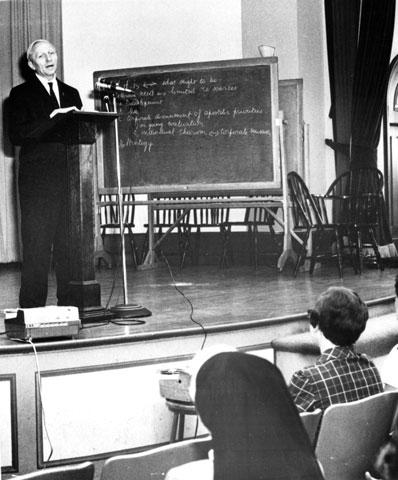
Redemptorist Fr. Bernard Häring speaks at Trinity College in Washington in 1970. (CNS photo)
The following is adapted from Fr. Charles Curran's contribution to Not Less Than Everything: Catholic Writers on Heroes of Conscience, from Joan of Arc to Oscar Romero, edited by Catherine Wolff, which will be published by HarperCollins in February 2013. Redemptorist Fr. Bernard Häring would have been 100 on Nov. 10.
My appreciation for Bernard Häring was summed up in the dedication of my 1972 book, Catholic Moral Theology in Dialogue -- "To Bernard Häring CSsR, teacher, theologian, friend, and priestly minister of the Gospel in theory and practice on the occasion of his sixtieth birthday." As a very young priest of the diocese of Rochester, N.Y., I was doing doctoral work at the Alphonsian Academy in Rome from 1959 to 1961. I was scheduled to teach moral theology at the diocesan seminary in Rochester. After four years of theology at the Gregorian University, I was opening up somewhat from my conservative theological orientation and my commitment to the moral theology of the manuals. I did not write my dissertation with Häring, but I was truly thrilled and nourished by his classes (in Latin) in which he developed his approach to moral theology. At my invitation many fellow priests living with me at the American college in Rome came to hear him and were greatly impressed.
In 1961 I started teaching in the seminary in Rochester, trying to emulate the approach of Häring. One year, early in my teaching the two-semester course, I did not open the required manual until March 1. I first wanted to show the full depth and breadth of the Christian moral life before getting into the manual. I later read in Häring's autobiography that he had done the same thing when he began teaching moral theology. I was the primary mover in bringing Häring to the United States in 1963 to give lectures and workshops during the summer. In subsequent years Häring came back many times to the United States during the summer, but also traveled through many parts of Africa, Latin America and Asia, giving lectures and retreats.
On July 29, 1968, Pope Paul VI's encyclical Humanae Vitae reiterating the condemnation of artificial contraception for spouses was publicly released. I was the leader and later the spokesperson of what started as a group of 10 of us, mostly from The Catholic University of America, who read the encyclical that night and drafted a response to it. Our 10-short-paragraph statement concluded that Catholics could responsibly decide to use birth control if it were for the good of their marriage.
After finishing the statement, we called a number of other theologians in the country, looking for more signatures. I reached Häring in California, read him the statement, and was ecstatic when he agreed to sign. On the morning of July 30, I acted as the spokesperson for the then 86 Catholic scholars, including Häring, who had signed the statement. Ultimately more than 600 signed. This forthright and early response to the encyclical gained worldwide attention. Häring himself then and later without doubt became the most prominent and public proponent in the Catholic world for disagreeing with the conclusion of the encyclical.
In the summer of 1979, I was informed that I was under investigation from the Vatican Congregation for the Doctrine of the Faith for my dissent on a number of moral issues. That fall I went to Rome to consult with Häring and others. Throughout the process I stayed in close touch with Bernard. After much correspondence back and forth it became clear in late 1985 that the Congregation for the Doctrine of the Faith was going to take action against me, which they ultimately did in declaring that I was neither suitable nor eligible to be a Catholic theologian. However, they did agree to have an informal meeting of myself with Cardinal Joseph Ratzinger and some officials of the congregation in March 1986. I was able to bring one advisor. All along Häring had agreed that if there were such a meeting he would accompany me.
Häring's presence was a source of great strength and consolation to me. He began the session by reading a two-page paper titled "The Frequent and Long-Lasting Dissent of the Inquisition/Holy Office/CDF." It was Häring at his forthright best at speaking to power. In the end he strongly urged Ratzinger to accept a compromise that I would not teach sexual ethics at Catholic University and there would be no condemnation. The meeting ended without any solution or action.
The next day, the fourth Sunday of Lent, six of us went to Häring's religious house to celebrate a liturgy at which he presided. The Gospel was the parable of the prodigal son. Häring in the homily looked at me and said that the church was the prodigal son who had taken all my treasure and my work for moral theology and fed it to the pigs. But the Holy Spirit was calling on me and the others present to take the role of the Father and forgive the church. Only with a spirit of forgiveness and hope can we continue to celebrate the Eucharist. He ended the homily by repeating twice that Christians are people who have hope.
In the last few years I have often been encouraged by the witness of Bernard Häring. A defensive centralization continues to mark the attitude of the Vatican to any attempts to bring about change. John Paul II recognized there was a crisis in moral theology because many moral theologians today dissent from papal teaching. But the popes have adamantly fought such change and even taken punitive action against those who have dissented on matters that are not essential to the Catholic faith. Meanwhile all of us have seen family and friends leave the Catholic church because of its intransigence. Many people have asked me if I see any signs of hope in the church today. I remind them and myself that hope is not hope if you see it in front of you. St. Paul tells us that hope is hoping against hope. Hope is believing in light in the midst of darkness and life in the midst of death.
Bernard Häring was truly a person of hope. He faced death many times in World War II. He almost died in operations trying to cure his throat cancer. The person who spoke in more languages to more people in all parts of the world than any other theologian, preacher or missionary later had his vocal cords removed and had to learn to speak from the esophagus, which was not easy both for him and for his listeners. In the last years of his life he experienced the return of a centralization and authoritarianism he thought had been vanquished by Vatican II.
Häring's witness of critical love for the church, his forthrightness, and his hope even in the midst of darkness enabled him to continue the struggle for church reform. His witness gives hope and strength to all.
[Charles E. Curran, a priest of Rochester, N.Y., diocese, is the Elizabeth Scurlock University Professor of Human Values at Southern Methodist University in Dallas.]




